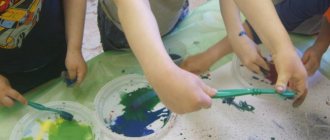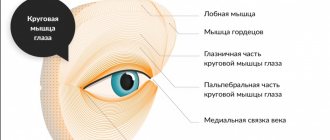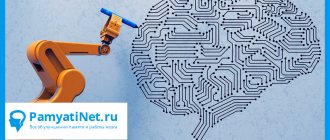Stages of development of spatial thinking
The ability to think in space consists of 5 phases:
- Analysis is the division of a subject into its component parts.
- Synthesis, during which the parts obtained during the analysis are combined into a single whole.
- Abstraction – in a given task, the sequence of actions necessary to solve it is determined and highlighted. At this stage, concepts are formulated.
- Generalization, during which key parts in a subject are identified and then compared.
- Concretization concerns the identification of phases inherent in a given task, which are in no way related to the solution of the assigned task.
The stages of formation of spatial thinking correspond to the periods of development:
- Initial, manifested in infancy, when the child begins to form connections between analyzers.
- Understanding location in space is a skill that develops by the age of three.
- Ideas about the world around. They are formed in older preschool age.
- Understanding space as a system is a skill that is acquired in primary school.
What it is?
To fully find out what this phenomenon is, let’s pay attention to its components - thinking and logic itself.
Thinking is understood as a mental process during which information is processed and connections are established between events, objects or phenomena. The factor of subjectivity, that is, a personal attitude towards something, is very strong here.
Logic leads our thinking to objectivity. Simply put, this is the science of correct, true thinking. It has its own methods, laws and forms. The “cornerstone” for her is experience and knowledge, not emotions.
In order to come to simple conclusions, common sense is enough. But in difficult situations, one cannot do without appropriate thinking, which helps to “work out” the most correct course of action even with a minimum of facts.
Important! It is better to do the first exercises once. For example, solve one crossword puzzle or play a few simple games of chess. For starters, this will be enough.
Logical thinking is a process during which a person resorts to logical concepts based on evidence and prudence. Its goal is to obtain a reasonable conclusion based on the “given,” that is, specific premises.
There are three types of logical reasoning:
- Figurative-logical. With it, the situation seems to be “played out” by the imagination, while we remember the images of the objects involved or the features of the phenomena. Yes, you can call it imagination.
- Abstract. Here it is more complicated; categories, objects or connections are used that do not exist in reality (that is, abstractions).
- Verbal , in which people share their logical judgments with others. What is important here is not only a penchant for analysis, but also competent speech.
Having learned what logic is, let's see how it can be useful in life.
Exercises for children
It is easiest to develop in childhood. At this time, the brain is open to external influences and can undergo any changes. Exercises for children differ from those offered to adults, but are no less effective.
Best exercises:
- Reverse reading of inscriptions. Parents should invite their child to play a game in which they read the signs they see in reverse order. It will be very difficult to do this with all the advertising posters. Therefore, additional conditions should be negotiated (for example, read only red signs).
- Drawing unusual animals. The child must draw an animal consisting of parts of other animals. When the drawing is ready, you need to come up with an unusual name for the new species.
- Shadow play. With the help of his hands, on which the light from a lamp falls in the dark, the child must create unusual shadows depicting certain things. You can even invite him to act out his favorite fairy tale using shadows.
- Mental arithmetic. The child will be required to calculate simple examples using special abacus called an abacus. Such training will also develop perseverance and general intelligence.
- Puzzles. You need to choose puzzles, rebuses, anagrams, etc. games, taking into account the baby's preferences. His task will be to solve all the problems provided. At an older age, you can add crosswords to them.
- Studying clouds. The child should look at the clouds together with his parents and name what exactly he sees. The ability to visually evaluate each cloud for its similarity to different objects or animals increases the chances of successful development.
- Construction. Parents need to give their baby a task, which involves building certain objects from toy blocks. This will help develop imaginative thinking and creativity.
- Associations. The baby needs to come up with associations for everything he sees or feels. You can also ask him to imagine animals by hearing the sounds they make.
- Classification. The child needs to sort all available things or toys according to certain criteria. For example, by shape, weight or purpose. Parents should monitor the process and give hints if necessary.
- Questions. Parents should ask their child “why?” and “what if?” questions. etc. to make him think and analyze the situation. You can ask at any time.
Such simple exercises will allow you to achieve good results in a few weeks of training. It is recommended to combine them with other activities that will be aimed at developing general intelligence.
How to develop logical thinking in another way
Try writing a diary, or take up poetry, or try to talk about something in writing
It doesn’t matter if it turns out to be a story, or a note, or a sketch, or a poem (blank verse is also welcome!). Why does this work? Because logical thinking is inextricably linked with speech, and is realized mainly in the form of signs and concepts
Why does this work? Because logical thinking is inextricably linked with speech, and is realized mainly in the form of signs and concepts.
What to do if creativity is “not your strong point”?
Firstly, it’s still worth trying, and if you don’t even want to try, you can take a different path. To do this, name any three objects at random, for example: an elephant, a chair, a fan. Now come up with a sentence in which all three selected objects can logically fit. For example:
There was a plate of sliced fruit on the chair, and Timka was sitting on the carpet, watching a cartoon about an elephant, chewing a slice of apple and waving his grandmother’s fan.
Or show your imagination by combining the words hammer, fish, geyser in a sentence. For example, like this: “Grandfather threw a hammer into the geyser, and from the depths to the very top of the fountain a real fish flew up, not just an ordinary one, but a golden one, and threatened grandfather with its fin.”
How to develop abstract thinking in a child
Some people believe that abstract thinking either exists or it doesn't. Based on the principle of an innate gift, like an ear for music. And it is almost impossible to develop it, just as it is impossible to become a composer without hearing. In extreme cases, persistent training can bring temporary results that will gradually fade away. Only few people know that all children are born with an excellent ear for music, and if you start developing it in time, you can raise a successful musician.
Thus, abstract thinking is also initially present in all children.
If you work with a small child using special methods and perform exercises to develop thinking, the child will gradually begin to demonstrate extraordinary thinking abilities. It depends only on you how broadly your children will think.
Exercises for children
There are many exercises, games and techniques for developing abstract thinking in children. The choice is made in accordance with the child's personality and age, as well as on the basis of initial abilities. Below I have selected the most effective exercises that will be of interest to most children.
Clouds
This game is the most famous, free and simple way to develop abstract thinking. It can be played anywhere where you can see the sky. The point of the exercise is to explain what a cloud looks like. So a child can fantasize about puffs of smoke, cotton candy, dragons, birds and many other options, gradually developing his abstract thinking.
Shadow play
A game that you can't get bored of. The shadow itself is an abstraction, since it is not an object, but only its symbol, with which you can have fun playing. For the exercise you will need a lamp, a set of figures, a white wall or a sheet. With the help of such simple things, you can perform entire plays, the scenario for which will be any of the fairy tales. Also suitable for development is an exercise - shadows on the wall. You need to create some kind of image with your hands, and the child must guess from the shadow who you are portraying.
Mental arithmetic
A serious technique for the development of children from 4-5 years old, because from this age, the child is able to perceive a given amount of information and concentrate attention for a certain time. Mental arithmetic is a special type of counting that helps to use both hemispheres at the same time
The exercise allows you to develop abstract thinking in a child much more intensively compared to other methods, while maintaining harmony between the hemispheres of the brain. Mental arithmetic increases the speed of perception, information processing, and also increases the speed of mental calculation.
Constructor
What books should you read to develop your intelligence and vocabulary? How to improve brain function: productive ways and recommendations
Conversation
Discussing any daily activities or objects with children helps them develop more effectively. Discussing these events allows the child to learn to imagine ideas, thoughts and manipulate symbols in his head.
Constant conversations with adults help children form correct speech.
Ask children to think about the future day and plan it, present their thoughts and ideas in different ways.
Methods for developing creative thinking
The workload in modern schools is more aimed at memorizing and applying information than at developing creativity and creative thinking. General education involves solving various tasks without using a non-standard approach: it happens that a student may even have their grade reduced for solving a math problem using a method that is not included in the program. On the one hand, this approach disciplines, teaches to adhere to generally accepted frameworks, on the other hand, it does not allow creative potential to unfold and has a negative impact on the quality of education.
Thanks to the left hemisphere of the brain, logic and analysis, so necessary for schoolchildren, are used. The right hemisphere, which is responsible for imagination, dreams, color perception and creativity, does not receive the same load. Most training programs operate in a targeted manner, participating in the formation of one specific ability. For this reason, it is necessary to choose a methodology that will help to diversify a person’s skills.
A program that ideally suits these parameters is mental arithmetic. She uses methods that allow not only to use both hemispheres of the brain, but also to improve the interaction between them. In addition, after completing the course, the student’s performance in both the humanities and the exact sciences noticeably improves: the child begins not only to instantly perform arithmetic operations in his head, but also improves brain function in general. The right hemisphere receives a load and begins to function as effectively as the left, which means creativity increases.
Mental arithmetic is a universal brain training that provides an excellent basis for both school and adult life. To achieve the maximum effect from classes, it is important to choose a center of additional education, where this course is taught by experienced teachers and using a unique methodology. Then the results of the training will be quite well consolidated, and the acquired skills will remain for life.
Problems and tasks for spatial thinking
Gradually move from simple tasks to more complex ones.
Simple games to develop spatial thinking for children from 3 years old
The main goal of gaming activity, starting from the age of 3, is the formation of new skills and the development of those already acquired
It is important to provide the child with as much knowledge as possible about existing geometric shapes and their possible location in space
- Game "Place the cat". The bottom line: ask your child to imagine any insect or animal and ask him to think about where it might fit (box, mug, closet, etc.).
- Game "Put it right." Place objects in front of the child and ask them to arrange them based on your instructions - to the left, to the right, further or closer. You can take it for this game.
"Metamorphoses". The idea is simple: you need to draw a circle behind a square, a rectangle behind a triangle, and so on. The task can be complicated by moving on to three-dimensional figures (cubes, cylinders, spheres).
- "Special agent on a mission." The child needs to look carefully at the room he is in in order to remember the objects in his environment. Then you need to ask him questions while the child, with his eyes closed, tries to reproduce in his mind what he saw.
- "Drawing on the back." The game is simple: you draw figures on the child’s back, and he tries to guess them.
- "Fly". The game involves 3 people: 2 players and 1 presenter. The essence: a 9x9 field is presented, a fly is placed in the upper corner on the right. The presenter, marking on the diagram, tells the path of the fly, after the word “stop” the participants voice the expected place of the fly. The one who names the correct position wins.
- "Route of movement." Using a map, you show your child the starting and ending points, and he, in turn, names each turn and tells his route from point A to point B.
- "Magic bag" You need to put different three-dimensional figures into a small bag so that the child can then guess by touch what is inside.
- Simple tasks with paper. Since the games listed above require certain consumables and time, you can use the simplest option - take paper and pen and come up with your own simple games: Figures from dots according to the pattern
- Repeating line patterns
- Finishing the mirror half of the picture
- Mathematical dictations and so on
Exercises for middle preschool children
- Story games:
- “House of Toys”: toys are placed in the closet, then the children are asked to play with them (they say the toys are tired and want to have fun), after the game they need to put the toy in the place where it stood before.
- “Who lives where?”: a tree is created on which the animals are located, you need to ask the children to carefully look at the image and answer the questions about who lives and where.
- In a similar manner, you can come up with many stories.
- Hide and seek games. Hide and seek develops spatial thinking in the form of a game. In order to win, you need to hide well, and for this you need to find an advantageous place, be able to navigate the place in order to avoid the leader.
- Outdoor games. Active games are based on the ability to navigate in space. Catch-up - good orientation on the spot and speed allow you to win the game. This type of activity will also help get rid of information overload in children.
Tasks for children of senior school age to develop spatial thinking
A whole set of educational board games for children and adults
- Graphic dictation is one of the educational games aimed at children aged 6-11 years. Dictations help develop not only fine motor skills and coordination, but also spatial thinking.
- . Train concentration skills, strategic and spatial thinking.
- Game "traffic controller". Using a map, you show your child the starting and ending points, and he, naming each turn of the route, describes his route to the destination.
- Labyrinth. The child follows the instructions with his eyes closed, drawing a path on a piece of paper according to the words of the leader.
- The mirror is the opposite. The rules are simple: you show certain actions, the child repeats, as if becoming your reflection.
- Word games. There are many different word games (cities, two truths and one lie, associations and many others). They all use imagination and the ability to perceive information by ear. Care is also important to follow the rules of the game.
Forms of abstract thinking
With abstract thinking, a person operates with different knowledge and mental experiences. Over time, all this came to a certain system. Many phenomena of the world are not subject to sight, hearing or touch (and about some we can say that they do not exist at all as such). But such phenomena are part of human life, and therefore must have at least some form.
There are three main forms of abstract thinking: concept, judgment and inference. Let's talk about them briefly.
Concept
A concept is a thought that conveys a common property of various phenomena. Properties may vary, but be homogeneous and similar, which allows them to be combined into one group. Let's take a car for example. It can be an SUV, sedan or hatchback; Different cars have different shapes, colors, characteristics. But their common feature is that they all have wheels, an engine, a gearbox, etc., and that they can be driven. These characteristics (design, purpose) allow properties to be classified into one group.
And we are taught such things from the cradle. Mom talks about “cat”, and we immediately understand that this is a meowing and purring four-legged animal with a tail, etc. Cats come in different breeds and colors, but they all have common characteristics by which they belong to the general concept of “cat” or “cat”.
Judgment
A person uses judgment with the intention of confirming or disproving something. It can be simple or complex. Here is a simple thing - “the cat meows” - it can be expressed specifically and unambiguously. But the complex one - “the cat began to meow because he was hungry” - can be expressed in several declarative sentences.
Also, propositions can be true or false. True ones reflect the actual state of affairs and are based, as a rule, on the absence of an individual assessment of a person, i.e. he judges objectively. A false judgment becomes when a person expresses his interest based on personal reasons, and not on what is actually happening.
Inference
An inference is a thought formed by two or more judgments. This is a new – more complex judgment. Any inference consists of a premise, a conclusion and a conclusion. The premise is an initial judgment, the conclusion is logical thinking leading to a conclusion.
These three forms of abstract thinking form its basis. We operate all abstractions with their help. But what we have said (forms and types of abstract thinking and abstractions, their goals, etc.) may not be entirely sufficient for understanding abstract thinking and its features, since, in essence, all this is theory. Therefore, it makes sense to talk separately about specific examples.
How to train your brain?
There are many ways to do this. Let's list them, and at the same time find out how they help develop logical thinking in an adult.
Logic problems
There are a great many of them, and it’s better to start with the simplest ones. Books will help here, and there are plenty of them on the Internet. The difficulty is increased gradually, making sure that the previous level is no longer difficult.
They can be different in form: from riddles to full-fledged problems with diagrams (such as “in what sequence will the cars be attached to the shunting diesel locomotive”). Take your time, think about all possible solutions.
It happens that the first levels are completed easily, but then it’s a bit of a grind. Don’t despair, give your brain a little rest, and the solution will definitely come.
Don’t be afraid to peek at answers (especially at the very beginning of class). Once you know the inputs and solutions, you can calculate a logical solution path and apply it to other situations.
Important! Reading serious books - historical, philosophical or popular science - also helps. There is no point in “swallowing” hundreds of pages of them; read little by little, pondering the information.
In many serious companies, HR specialists give candidates such problems during interviews, assessing the speed of solution and the reasoning of the answer. They can be either purely professional or without reference to the type of activity. So you'll have to work on your logic.
Board games
The first thing that comes to mind is chess. A leisurely game requires analysis and thoughtfulness, while reaction speed is not needed here. You can play with anyone, but it is better to choose a stronger opponent who can show the fastest and most effective combinations. After just a few games, you will notice that you yourself are playing complex etudes, counting on a move or two ahead.
To improve brain function, you should eat walnuts, beets, fish, carrots, pasta, bread
There are also a lot of other games - entire thematic sets are offered, based on the plots of popular books or TV series. This is a great way to pass the time with friends or family, while at the same time keeping your logic in good shape.
Tests
There are also plenty of such games of intelligence. This is a great tool for those who are thinking about how to develop logic. Some of them come with a countdown, but this should not be annoying.
They all use the “cause-effect” principle. That is, the initial data may have several solutions, but only one will be correct. Despite all the apparent simplicity, it will be difficult for an unprepared person at first - the answer options often seem mutually exclusive, although they are composed in such a way that it seems that any one is suitable. This is the essence of training.
Did you know? The Russian philosopher Nikolai Aleksandrovich Vasiliev is considered one of the “fathers” of modern (or non-classical) logic. Having started his work back in tsarist times, already in 1918 he entered the list of “old” scientists recognized by the Soviet government.
The number of questions can be any - from 10 or more, so you can “indulge” in such tasks even during your lunch break.
Crosswords and puzzles
Everything is simple here. Trying to fill all the cells with missing words, we “scroll through” all our knowledge.
Recently, children are increasingly moving away from live communication into computer or video games, the Internet, and becoming dependent on them. Introducing the habit of joint educational games will help distract your child from the computer.
Japanese Sudoku is more difficult. The cells have to be filled in so that in each 3x3 square (and there are usually 9 of them) the numbers from 1 to 9 appear once, and the same story with large lines and columns. Start with the simplest ones, usually the difficulty is indicated in the task.
An excellent way would be to solve graphic crosswords, at least the Japanese ones. They have one solution in the form of a picture. It will work if you shade the cells correctly (based on the indicated numbers). Here, too, you can peek at the solution and compare it with the initial data - it can be difficult to get your bearings right away.
You can try making your own crossword puzzle. Making riddles can be more difficult than looking for the answer, especially since you have to correlate the location of letters and cells.
Study of deduction and induction
In order not to complicate things, we immediately note that the deductive method provides a conclusion from the general to the particular, and induction, on the contrary, brings the disparate to the general.
Important! A diary helps analyze the connection between events.
To some it seems archaic, but at times it is useful to re-read old notes and recall subsequent actions in memory and “calculate” possible options for their development. Deduction is pure logic, but it has one weakness: the underlying facts must be true.
Here is an example of such a conclusion: “all racing cars are difficult for ordinary drivers”, “I am an ordinary driver”, therefore “I cannot cope with a powerful car on the track”. In life, we more often use the inductive method ; such reasoning is based on facts that may turn out to be untrue. Then our conclusions have to be substantiated. This often leads to hasty generalizations and wrong decisions. There is also the so-called incomplete induction, in which the conclusion significantly exceeds the “sum” of the individual facts.
These abilities can be developed by mentally “driving away” various everyday situations and cases.
Disorder disorders
Thought disorders are disorders of mental activity. Violation is divided into quantitative and qualitative.
Quantitative forms of the disorder are characterized by speech impairment, delayed neuropsychological development, or mental retardation.
Forms of quantitative disorder:
- mental retardation (MDD) is diagnosed in children 2-3 years old. Treatment is prescribed by a neurologist.
- Oligophrenia (mental retardation is characterized by impaired development of a child from an early age). A child with oligophrenia is observed by a neurologist and psychotherapist. The goal of treatment will be socialization and learning self-care.
- Dementia is a disorder of mental processes that manifests itself in adulthood or adolescence. Observation by a psychotherapist.
The speed of thinking depends on the predominance of processes in the cerebral cortex. This may be excessive excitement or, on the contrary, inhibition of mental activity:
- Disruption is characterized by a rapid change of thought, in which speech becomes absurd, logic and consistency of judgments are completely absent. Speech consists of fragments of phrases quickly replacing each other. The grammar of speech is usually preserved. This disorder is inherent in schizophrenia.
- Manic syndrome is characterized by accelerated speech and a simultaneous increase in psycho-emotional background. Speech is accelerated, the patient can speak “excitedly”, especially pronounced in certain topics.
- Slowing down of mental processes is inherent in depressive syndrome. Distinctive features: absence of thoughts in the head, slow speech taking into account the slightest details that are not related to the essence of the issue, predominance of a depressed mood.
- Thoroughness is expressed in excessive “drowning” in details. The patient has difficulty switching from one question to another, and rigidity of thinking is observed. Circumstances are inherent in diseases of the nervous system (Epilepsy).
- Reasoning is revealed during long-term communication and is expressed by a tendency to teach. When a person does not answer the question posed, but talks about things that have nothing to do with him and strives to teach life to everyone with whom he begins to communicate.
- Autism develops in withdrawn people. A distinctive feature of this disorder will be isolation from the world, poor orientation in society and immersion in internal experiences, which often do not correspond to the real state of affairs.
- Obsessive syndrome is characterized by obsession with ideas or thoughts that the patient cannot get rid of, although he understands the absurdity. Obsessive thoughts depress a person, cause negative emotions, make them suffer, but the patient cannot cope with them. They arise against the background of persistent excitation of a part of the nervous system.
- Phobias (unreasonable fear). Various phobias arise against the background of overexertion and performing a difficult task for an adult or child. In childhood, fear of punishment gives rise to various phobias.
- Extremely valuable ideas arise in adolescence. The predominance of a brightly colored emotional background indicates the development of this syndrome. This disturbance of consciousness does not cause suffering to the patient.
- Delusional thinking (often accompanied by hallucinosis) is characterized by the emergence of persistent thoughts of ideas that cannot be convinced. Inference is based on a logical conclusion made on the basis of some data. This could be fear of persecution, unreasonable jealousy, self-flagellation. Delusional thinking can be dangerous for others and the patient with a pronounced syndrome. Treatment by a psychotherapist or psychiatrist is required.
Pathology of thinking often provokes disturbances in the emotional background (depression, euphoria, apathy). Any disturbance in the thought process should be observed by a specialist. If necessary, psychocorrection or drug therapy is carried out. Ignoring the pathology of thinking can lead to persistent mental pathology and cause serious problems for societies or the patient.
Diagnosis of thinking involves determining the type of excitation of brain activity and the characteristics of thought processes. The ability to solve current problems is also taken into account. The development of speech and thinking is closely related and begins at an early age.
With delayed speech development, there is also a disturbance in mental activity
It is important to notice deviations in time and begin training your thinking, using available methods for developing thinking (game, action, training)
Signs characteristic of abstract thinking
The ability to think allows you to abandon unnecessary details and see a difficult situation from a new perspective. This means that the opportunity to make a discovery increases. Or find an original solution to a problem when the situation seems hopeless. It is necessary to remember what features abstract thinking has.
- Not tied to the senses (which is what makes it different from a specific one)
. You don't have to be near the object of your thoughts to get fresh information. It is enough to rely on your experience. For example, having received a bad grade, a student already knows what awaits him at home. - Summarizes various objects and identifies patterns in the surrounding world.
Generalization simplifies information and speeds up access to it (by memorizing characteristic features). For example, if several people are asked to imagine a dog at the same time, they will imagine dogs of different breeds, but they will all imagine these particular animals with their inherent traits. - Closely related to speech - the verbal expression of thoughts.
Thoughts tend to “sound” in our heads. It is language that is the means of expressing and consolidating information.
If you keep these three characteristics in mind, you can easily distinguish those things that are not a form of abstract thinking. For example, performance. After all, it is inextricably linked with the perception of our senses. Even if at the moment you are not near the object, you were once there and could study it, and then simply remember. Ideas about the taste of food, the image of a person, cold or warmth do not relate to thinking; they are much closer to perception.
Abstract thinking
Abstract thinking is engaged in the search and establishment of general patterns inherent in nature and human society. Its goal is to reflect through concepts and broad categories some general connections and relationships. In this process, images and ideas are secondary; they only help a more accurate reflection.
Thanks to the development of abstract thinking, we can perceive a general, holistic picture of phenomena and events, without getting hung up on the details, abstracting from them. By following this path, you can go beyond the boundaries of the usual rules and make a breakthrough, discovering something new.
The development of abstract thinking was greatly facilitated by the creation of a language system. Words were assigned to objects, abstractions and phenomena. The meaning embedded in words became possible to reproduce regardless of the situations associated with these objects and their properties. Speech made it possible to turn on the imagination, imagine this or that in the mind and consolidate reproduction skills.
Abstract thinking reflects reality in the form of concepts, judgments and conclusions.
• The concept reflects and unites objects, phenomena and processes through any significant features. It became the primary and predominant form of mental abstract representation of events. Examples of concepts: “wolf”, “1st year student”, “tall young man”.
• Judgments either deny or confirm phenomena, objects, situations, etc., reveal the presence or absence of any connections or interactions between them. They can be simple and complex. An example of a simple one: “a girl is playing with a ball,” a complex example: “the moon came out from behind the clouds, the clearing lit up.”
• Inference is a mental process that allows you to draw completely new conclusions from an existing judgment (or judgments). For example: “All birch trees shed their leaves in the fall, I planted a birch tree, therefore, it will also shed its leaves in the fall.” Or the classic: “All people die, I am a man, therefore I will also die.”
Abstract-logical thinking through logical operations with concepts reflects the interconnections, relationships between objects and phenomena in the world that surrounds us. It favors the search for unusual solutions to a wide variety of problems and adaptation to constantly changing conditions.
There are some features inherent in abstract-logical thinking:
— Knowledge of concepts and criteria, both existing and only supposedly existing in the real world and the ability to use them.
— Ability to analyze, summarize and systematize information.
— The ability to identify patterns in the surrounding world even without direct interaction with it.
— Ability to form cause-and-effect relationships.
Abstract-logical thinking is the basis of the learning process, and it is applicable in any conscious activity, both in science and in everyday life.
The development of abstract thinking occurs in childhood, and it is very important to pay due attention to it. In one of the subsequent articles we will talk about how to develop abstract logical thinking in a preschool child
The flexible mind and receptivity of a child at an early age make this period the most optimal for classes. However, an adult can develop his abilities, logical skills, and improve his ingenuity and intelligence. Abstract logical thinking is helped by developing exercises for identifying patterns, combining words based on a common feature, and any logical tasks.
It has been proven that until a very old age we can develop the abilities of our brain, improving its functions such as thinking, attention, memory, perception. Classes can be conducted in a fun way using online gaming simulators
We wish you success in self-development!
Photo: Bill Gracey
Exercises for developing thinking
- This exercise will help increase the flexibility and productivity of thoughts in the shortest possible time. Place any object in front of you. For example, a vase or pepper shaker. Doesn't matter. Note the time on your watch. 5-10 minutes, no more. During this time, try to come up with as many ways as possible to use this item. You can take any options into account, as long as they are not completely stupid. In order to diversify this exercise, it can be performed in pairs or in whole groups. This way, the activity can be given a competitive spirit.
- This exercise is designed specifically to develop associations. This time, take two completely different objects. For example, tape and sneakers or a pencil and a plate. Time it again for 5-10 minutes. During this time, find common features in the selected items. Each time the exercise will become easier and easier.
- Description of the object. Now imagine an object, animal or person in front of you. Time it for 3-5 minutes. During this time, you must continuously describe the object, as well as express your feelings and thoughts about it. You can describe an object both in written and oral form.
- Another exercise in description. Choose for yourself any pair of words that are completely opposite to each other in meaning. For example, warm-cold, past-present, advantage-disadvantage. Now come up with as many words as possible for the selected words that describe them. You can also come up with adjectives. For example, warm - sunny, soft, welcoming and cold - icy, blue, fresh.
- Finishing. Take for yourself some familiar situation, for example, the alarm clock rang, the kettle boiled, or it started to rain. After that, take 5-10 minutes and try to come up with as many different options for continuing the story as possible. The more you come up with, the better.
Development of abstract thinking
Thoughts cannot be the same for every individual. Some are inclined towards painting, others towards music, others prefer poetry, but some can think abstractly
But such thinking needs to be formed and it is important to do this from early childhood. It is necessary to give the child the opportunity to fantasize, think and reflect.
In adults, it is already developed and it is extremely difficult for them to perceive new information. Thoughts can lose their flexibility over time. Below are exercises that will help combat this process. They are able to develop creativity and breadth of thought within themselves:
In your head you need to imagine emotions such as fear, joy, delight or doubt. What will pleasure look like? Or, for example, what will interest be like if it is not tied to individual objects.
Imagine some image of an idea. How can a person imagine harmony? Will this create an association or symbol? It is recommended to practice with such images as infinity, challenge, order, religiosity.
Turn the book over and read it from top to bottom. In this case, you need to read in a different order. It is necessary to establish a logical connection between the plot being reproduced.
Close your eyes and mentally imagine all the people with whom you communicated today
Pay attention to clothing and facial expressions, facial expressions, gestures. You can't miss a single detail
What does a person get when communicating? Take up drawing.
There are also exercises for children:
- Come up with new unusual names with your baby. Find an interesting picture online and try to choose at least 3 titles for it.
- Try to do dramatizations. Make costumes from available materials.
- Solve various puzzles and puzzles.
- Take a blank piece of paper and spill ink on it. Together with the baby, make some kind of face out of the stain.
It helps solve many problems. You need to think effectively and creatively. This will help you quickly make decisions and draw conclusions
Therefore, it is very important to improve yourself and pay attention to your abstract thoughts. But exercises must be done regularly. Only with effort and time can you get a good result.
Only with effort and time can you get a good result.
https://youtube.com/watch?v=C3RC5D-pn4c
Examples of abstract thinking
The clearest example of abstract thinking is the exact sciences, such as astronomy, physics and mathematics, etc. Most often it serves as their base. A person does not see numbers and formulas as such, but he can calculate, measure, count, combine objects into groups and find their quantity.
The same goes for life itself. What is life? This is when there is a body in which consciousness functions. We cannot give an exact definition of the concept of “life,” but we can say with precision when a person is alive and when he is dead.
Abstract thinking manifests itself no less clearly when we look to the future. We don't know what awaits us, but we have plans and goals, aspirations and desires. If we couldn't dream and imagine, we wouldn't be able to make plans for the future. Now we are making efforts to achieve results. Our movement through life has a direction. Abstract thinking gives us tactics and strategy that lead to the desired future. This reality does not exist yet, but we are trying to make it correspond to our ideas.
When considering examples of abstract thinking, one cannot help but recall idealization. Many idealize both the world in which they live and the people who surround them. There are, for example, men who dream of “possessing” a woman, and at the same time do not even think that one can only possess an inanimate object or a non-thinking being. There are also women who are waiting for a “prince on a white horse” and do not pay attention to what many “princes” are like in real life.
There is also an excellent example of false judgments. Let's touch on relationships again: some women believe that all men are “bad,” but this judgment is based on bitter experience - situations in which men betrayed these women. In any case, a woman identifies men as a separate class with its own specific properties, and therefore she can attribute to all of them what was manifested in one representative.
From false judgments, among other things, false conclusions often arise. For example, a house may be called “dysfunctional” because of faulty wiring, poor heating, or unfriendly neighbors. Based on his emotional discomfort that arises in the current conditions, a person makes unambiguous judgments, from which conclusions are formed that form a conclusion that distorts reality - after all, the house may well be “normal”, you just need to bring everything in it to mind.
There are many similar examples that can be given, but they will all say that abstract thinking (including the false judgments and inferences that arise from it) constitutes a colossal part of our everyday thought process. It manifests differently for everyone, and there will always be components that require development. Someone may be good at systematizing information, but find it difficult to isolate individual elements of events. Someone can perfectly find correspondences between the particular and the general, but have difficulty specifying something, etc. And in order to train your brain and improve your intellectual abilities, you need to develop abstract thinking.
Logical thinking: innate or acquired?
The ability to think logically is a trait that people acquire. This is confirmed by both psychologists and other specialists. No one is born with the gift of logical thinking already formed.
Even the simplest level, figurative and logical, appears by the age of one and a half years, when babies begin to analyze everything that surrounds them and gradually separate the important from the unimportant.
Important! Even something as frivolous at first glance as inventing new words or rhymes stimulates the development of logic.
Such skills are often called experiential, that is, those that are associated with personal experience. Unfortunately, they are often supplemented with templates that are “driven in” by the environment. This is how critical thinking abilities are lost.
Meanwhile, anyone can reach the level of abstractions. We often talk about non-existent phenomena, without even thinking about the fact that our logical apparatus is working hard at this time.
Teachers and “techies” will confirm that their own experience and regular training perfectly develop logic, even if a person was far from regular multi-level thinking. There would be a desire.
Development of spatial thinking in primary school age
A multi-level puzzle that helps you study the structure of the human body
The resulting basis of spatial thinking requires further development. To do this, you should continue to fold origami and puzzles, play Tetris, solve riddles and puzzles
It is important to pay attention to walks so that the child can navigate in space
How to develop spatial thinking at 5-7 years old
Interesting and inexpensive origami books and puzzles are suitable for children 5-7 years old
- walks during which it is necessary to help the child navigate in space,
- play games associated with various images (riddles, puzzles, origami, applications),
- online trainers for spatial thinking, board games
Why is imaginative thinking necessary for adults?
Developed imaginative thinking is necessary in many professions - for example, designers cannot do without it. The phrase “draw me something bright and memorable” should not confuse the employee; on the contrary, these words should be a catalyst for mental activity. Working on imaginative thinking helps develop analytical abilities. Exercises for developing such skills will be useful not only for workers in creative professions, but also for all those who would like to broaden their horizons.










